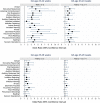Neurocognitive and Academic Outcomes at Age 10 Years of Extremely Preterm Newborns
- PMID: 27006473
- PMCID: PMC4811321
- DOI: 10.1542/peds.2015-4343
Neurocognitive and Academic Outcomes at Age 10 Years of Extremely Preterm Newborns
Abstract
Background and objective: Despite reductions in mortality and morbidity among children born extremely preterm, they remain at high risk of neurocognitive deficits, with up to 40% having significant cognitive deficits at school age. We assessed the rate of neurocognitive impairment in a contemporary US cohort of 873 children aged 10 years who were born <28 weeks' gestation.
Methods: The families of 889 of 966 (92%) children enrolled from 2002 to 2004 at 14 sites in 5 states returned at age 10 years for a comprehensive assessment of IQ, language, attention, executive function, processing speed, visual perception, visual-motor function, and academic achievement.
Results: A total of 873 children were assessed with well-validated tests of cognitive and academic function. Distributions of test scores were consistently and markedly shifted below normative expectation, with one-third to two-thirds of children performing >1 SD below age expectation. The most extreme downward shifts were on measures of executive control and processing speed. Multivariate analyses, adjusted for socioeconomic status, growth restriction, and other potential confounders, revealed that the risk of poor outcome was highest at the lowest gestational age across all 18 measures.
Conclusions: More than half of our extremely preterm cohort exhibited moderate or severe neurocognitive deficits at age 10 years, with the most extensive impairments found among those born at the lowest gestational age. Children born extremely preterm continue to be at significant risk of persistent impairments in neurocognitive function and academic achievement, underscoring the need for monitoring and remediating such outcomes beginning in early childhood.
Copyright © 2016 by the American Academy of Pediatrics.
Conflict of interest statement
Figures


References
-
- Johnson S, Fawke J, Hennessy E, et al. . Neurodevelopmental disability through 11 years of age in children born before 26 weeks of gestation. Pediatrics. 2009;124(2). Available at: www.pediatrics.org/cgi/content/full/124/2/e249 - PubMed
-
- Hutchinson EA, De Luca CR, Doyle LW, Roberts G, Anderson PJ; Victorian Infant Collaborative Study Group . School-age outcomes of extremely preterm or extremely low birth weight children. Pediatrics. 2013;131(4). Available at: www.pediatrics.org/cgi/content/full/131/4/e1053 - PubMed
-
- Løhaugen GC, Gramstad A, Evensen KA, et al. . Cognitive profile in young adults born preterm at very low birthweight. Dev Med Child Neurol. 2010;52(12):1133–1138 - PubMed
MeSH terms
Grants and funding
LinkOut - more resources
Full Text Sources
Other Literature Sources
Medical

